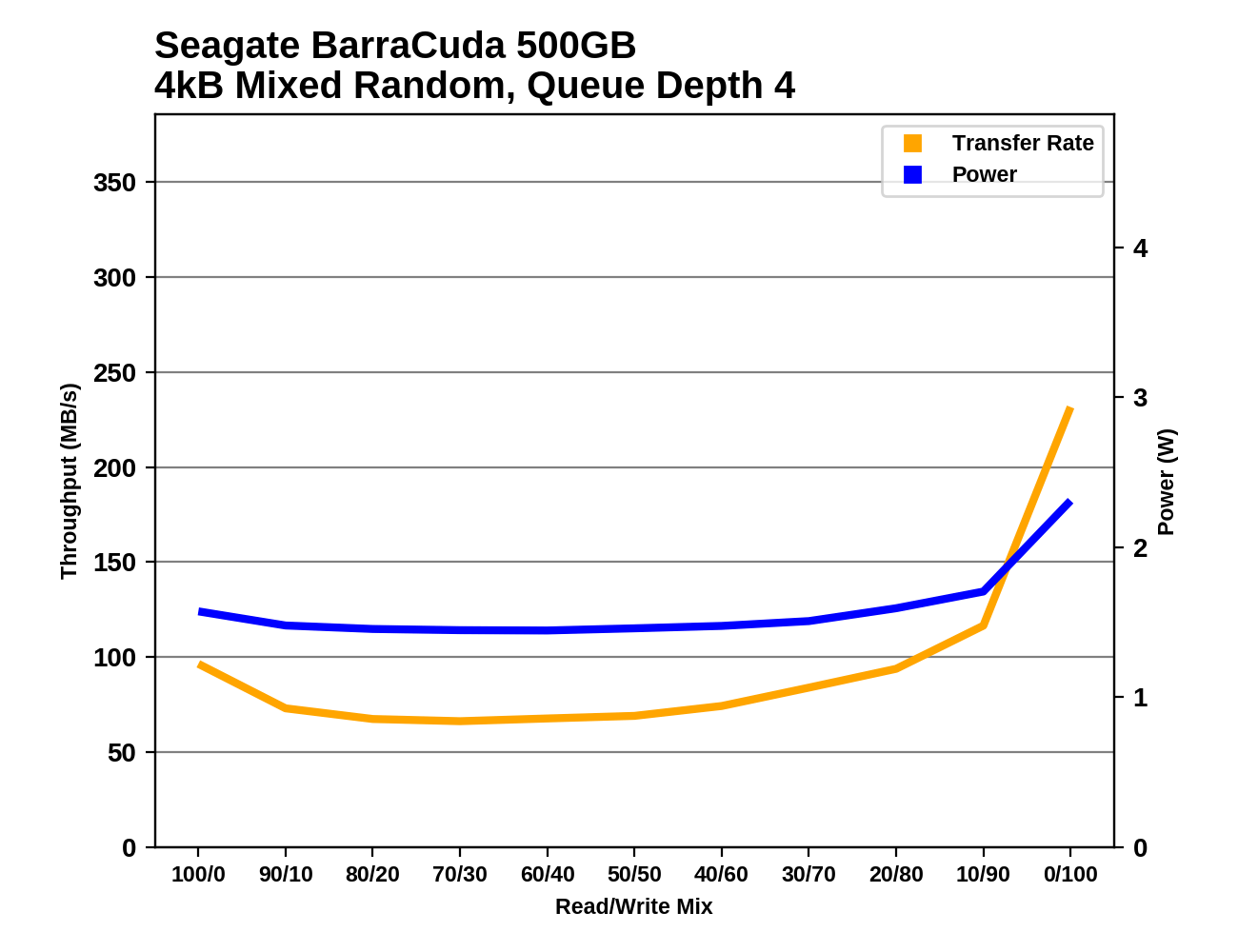The Seagate BarraCuda (500GB) SSD Review: Getting Back In The Game
by Billy Tallis on December 7, 2018 8:00 AM ESTMixed Random Performance
Our test of mixed random reads and writes covers mixes varying from pure reads to pure writes at 10% increments. Each mix is tested for up to 1 minute or 32GB of data transferred. The test is conducted with a queue depth of 4, and is limited to a 64GB span of the drive. In between each mix, the drive is given idle time of up to one minute so that the overall duty cycle is 50%.

The Seagate BarraCuda fares poorly on the mixed random I/O test, as do the other Phison S10 drives, even the PNY CS2211 with MLC NAND. The Plextor M8V is the next slowest drive with a mainstream controller, so it appears that the poor performance here from the Seagate BarraCuda is at least partly due to the NAND and is not just due to the Phison S10 controller.
 |
|||||||||
| Power Efficiency in MB/s/W | Average Power in W | ||||||||
Most mainstream SATA drives in this capacity class average around 1.5-1.6W during this test, so the efficiency rankings largely mirror the performance rankings. That leaves the BarraCuda again near the bottom of the chart.
 |
|||||||||
The fastest drives on this test are the ones that avoid performance drops when writes are added to the mix and instead steadily gain performance as the test progresses. The Seagate BarraCuda doesn't pull that off, with performance that drops when writes are first added to the mix and doesn't recover until near the end of the test when the workload is almost entirely writes.
Mixed Sequential Performance
Our test of mixed sequential reads and writes differs from the mixed random I/O test by performing 128kB sequential accesses rather than 4kB accesses at random locations, and the sequential test is conducted at queue depth 1. The range of mixes tested is the same, and the timing and limits on data transfers are also the same as above.

The Seagate BarraCuda had great sequential read performance and competitive sequential write performance, but it doesn't handle mixed sequential workloads all that well. As with the mixed random I/O test, the Phison S10 drives are all clustered at the bottom of the chart along with the DRAMless SSDs, while the other mainstream TLC SSDs offer at least 26% higher overall performance—and that comes from the Plextor M8V that uses the same Toshiba 3D TLC as the BarraCuda.
 |
|||||||||
| Power Efficiency in MB/s/W | Average Power in W | ||||||||
The BarraCuda is again one of the most power-hungry drives, surpassed only by the Phison S10 SSDs that use planar NAND, so it earns one of the worst efficiency scores. The slow DRAMless SSDs at least manage to use far less power during this test, so they end up with pretty good efficiency scores.
 |
|||||||||
The BarraCuda starts off with great sequential read performance, but as soon as writes are added to the mix, throughput plummets. It stays slow through most of the test, recovering only slightly toward the end to deliver just over 300MB/s on pure writes. That final write speed isn't too bad, but most mainstream drives spend the read-heavy half of the test performing well above that level, instead of below 250MB/s.










39 Comments
View All Comments
takeshi7 - Friday, December 7, 2018 - link
"they bought controller designer SandForce right around when SandForce drives disappeared from the market for good."That's not strictly true. Seagate still use controllers based on SandForce for some of their enterprise SSDs. Look for DuraWrite Technology in their marketing materials to know which ones.
The_Assimilator - Friday, December 7, 2018 - link
SandForce disappeared from the *consumer* market, to be precise. And it was all the more surprising because of how much they shaped the formative years of mainstream SSDs. Reading about the reasons behind that company's implosion in someone's autobiography is going to be interesting.mikato - Friday, December 7, 2018 - link
I would like to know this also. Did the top brains get hired away to somewhere else somehow right when Seagate bought them or what?DanNeely - Friday, December 7, 2018 - link
IIRC Rumor mill at the time was that their next gen controller wasn't competitive and unable to get the design wins they needed they ran out of money and got snapped up on the cheap.Qasar - Friday, December 7, 2018 - link
https://en.wikipedia.org/wiki/SandForceBeaver M. - Wednesday, December 12, 2018 - link
Nothing was surprising. Every expert knew they wouldnt last long with their focus on compressed performance and manufacturers promoting that without criticism.Many customers felt scammed when the controllers never delivered the performance they promised, because the real high numbers were only achievable with compressible content (who the hell has a 5 GB doc file?).
In every forum experts told people not to buy Sandforce SSDs or memory sticks, because of that fact. That sealed their fate.
HighTech4US - Friday, December 7, 2018 - link
Not competitive on price.$84.99 for the 500GB model.
I just purchased on Dec 4th a brand new Intel 545s 2.5" 512GB SATA III 64-Layer 3D NAND Internal Solid State Drive SSD from Newegg for $34.99 (after $20 PayPal coupon)
Death666Angel - Friday, December 7, 2018 - link
"after $20 PayPal coupon" So, Christmas offerings plus another coupon? Great comparison!HighTech4US - Monday, December 10, 2018 - link
So show me where I can get the this 500GB model for $54..99 then. That was what I paid pre-coupon for the 512GB Intel SSD.Like I said Seagate is not competitive on price.
Donkey2008 - Thursday, December 13, 2018 - link
I used a $50 Amazon gift certificate to get my Samsung SSD for $4.99. Seagate will never beat that price.(sarcasm)